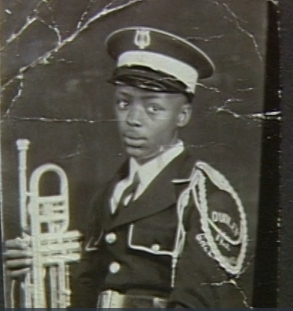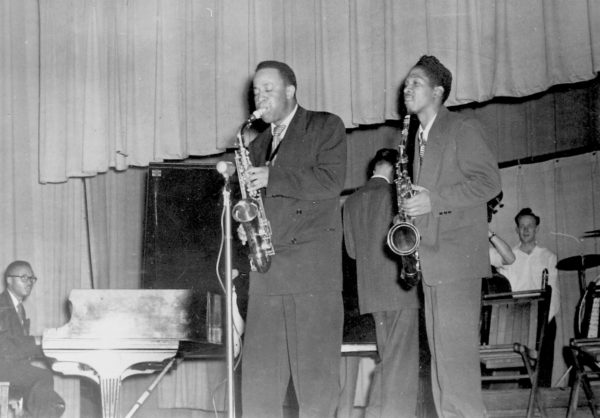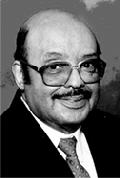
Carl Foster, UNC-TV, 1988.
Carl O. Foster, Jr., piano ( 1926- 2013)
Carl Foster grew up near NC A&T, in the same Greensboro neighborhood as B-1 veteran Charles Woods, who was 3 years older. That age difference kept him out of US Navy B-1; he trained in Chicago as a Navy bandsman with fellow Aggies Lou Donaldson and Jehovah Guy.
When he retired, at the conclusion of a 36-year career in education, he was Director of Cultural Arts for Greensboro City, in charge of drama and visual arts and vocal and instrumental music. “It’s hard to remember names,” he said, “but I did touch the lives of a lot kids and I was instrumental in seeing many of them become very successful because of my influence. That–that made me feel good. During my administrative career as an educator, I touched the lives of many teachers whom I was able to help who became very successful as music teachers or art teachers or whatever the case may be. And I feel that I played a pretty good and important part in making the music program in Greensboro what it is today and the cultural arts program what it is today.”
He played trumpet in Dudley High School’s band, directed by James Parsons, who left for the Navy with B-1 and nine of his seniors before school was out for the summer of 1942.

Courtesy of Carl Foster
He was only slightly younger than Raymond Pettiford, who was one of those high school seniors who joined B-1 prior to their graduation: “I met Petti when I was a freshman in high school and he was a freshman in high school. He had gone to elementary school over in Warrensville, on the other side of town, so I had never met him until we signed up for band that first year. He was already an excellent musician and we all started out together because we didn’t have band in elementary school at that time. So we both started in the beginners band at Dudley. And you wouldn’t believe it, but in one week’s time we both were promoted to the full band. I could play some piano at the time, you know, so it was just a matter of learning the fingering and getting a good embouchure on my trumpet. We played together until they left to go the Chapel Hill experience.”
Foster attended A&T for a year prior to enlisting. After his induction in Greensboro, he was sent to Chicago, where he became part of “the Great Lakes Experience,” where over 100 Black Navy bands would be trained in what Samuel Floyd has called “the greatest single educational and musical experience for Blacks ever to occur in America.” Foster said, “I was hoping to take the audition on piano but I took it on trumpet,” adding, “I’m one month older than Lou Donaldson, so he followed me a month later.”
That Chicago experience would indelibly mark the musical education and future of Foster, Donaldson, and Jehovah Guy. They were introduced to bop during its formation, loved it, and brought that new style of playing back to North Carolina with them at the war’s conclusion. “We were very fortunate to stay around Chicago for a while,” Foster said, “because there you had the best musicians around the nation that would often come in and out. The jam sessions gave us an opportunity to listen and grow and learn the new movement, which at that time was bebop.
“Back home, you know, if you were playing Count Basie or Duke Ellington or Artie Shaw or–you name it, that sort of swing–you were doing fine, but up there in Chicago it was altogether different. History says that bop started around 1945, ’46 but it was really earlier when this new concept of music comes about–Charlie Parker, Dizzy Gillespie–and no longer did you listen to the music to dance by but you listened to it for the artistic expertise of the musicians, because the movement had gone toward improvisation and chord substitutions. And no longer did the drummer keep the beat. The bass player began to keep the beat and the drummer used to do what they called ‘drop bombs,’ you know.
And so we came back to North Carolina [after the war] and as soon as we got back, I worked for a little minstrel show until school opened, and the next summer I suffered through playing that rinky-dink music backing up the people and doing the soundtrack [for “Pitch a Boogie Woogie”], though I was quite gratified in the end [of the film]. We did get a chance to play something we liked and you can tell it on the film, especially toward the end. But bop ushered in better musicians. You had to, you know, you had to be able to know your horn. you had to bae able to get over your horn. You couldn’t fake, you know. You had to know or else you had to sit down.” So we were able to learn that and come back home and be able to play it. But we had a problem because we had to get people here in Greensboro used to listening to it. But we did do that, at the Artists Guild [where Foster was resident pianist], and it eventually became a Mecca for modern jazz.
That “little minstrel show” he traveled with during the summer of 1946 was Silas Green from New Orleans, the last of the big time traveling Black tented vaudeville shows. He was discharged from the Navy on July 6, 1946, and once back in Greensboro, heard from a friend who was playing saxophone with Silas Green that the show was in need of a trumpet player, so Foster and another friend, Irving Stokes, “an excellent trumpet player,” joined the show in Greensboro and toured with them until school began in September.
In every town–“Galax, Roanoke, Harrisonburg, places like that”–he recalled, “Our show would come out and do what they called the “bally”–they’d do their little dance and everything to try to entice the people to come in and see the show. That was a different kind of experience for me. So really, when I got down to Greenville [to record “Pitch”], I was used to the sort of floor show, dancing-girl type thing that we had to play for the film.”
But the road experience was hard: “We would have to stay in private home. Somebody would go ahead and nail down some rooms at a rooming house or with private families where we could stay and also where we could be fed because nothing was open to us at that time.”
During the school year, Foster also began playing with Max Westerband, the local “king of swing,” which employed most of the Rhythm Vets at one time or another. He also had his own combo, and he became the house pianist for the Artists Guild, one of the most important of the post-war jazz venues in the South.

Live at the Artists Guild (L to R): Carl Foster, Lou Donaldson, Billy Toles.
The Guild, he said, was a group of Greensboro artists who decided to open a night club–“each contributed their personal funds”–and called it the Artists Guild: “They decorated the Guild by doing paintings and sculptures, things of that nature. When bands would come through town, they wanted to hear us [Foster on piano, Donaldson on alto sax, Jehovah Guy on drums, and Billy Toles on tenor sax] and they came and they played and listened, and they went on and told the story elsewhere. So every time a big band came to Greensboro, after the dance you look for the jam session to last way over into the morning, because that’s where everybody would head. Anybody who aspired to be a bebop musician would come there.”
One of his fondest memories is of the night they cut John Coltrane: “He was a youngster, a teenager, and he came up and there were about 15 tenor players lined up to play. I’m the only pianist there. Some guys would take 12, 15 solos. So we decided that maybe we needed to play something difficult and play it in a difficult key. So John Coltrane came up and we decided to play “Cherokee,” and that’s one of the most difficult jazz pieces to play. John Coltrane decided that he could play it so we went to the key of B, he could not handle it, and I laugh about it now, because he turned out to be a great musician, but at that time, he had to put his horn up, because he couldn’t play with us. But everybody that passed through Greensboro that was in a band would stop by because it was the best thing between Washington, DC, and Atlanta for good music.”
I asked him if the purpose of “cutting” is to eliminate a player, but he says “not necessarily so,” that it was more a matter of stage economy–but also of protecting turf.
“Donaldson would cut just about every alto player who came in town,” he said. “But what I’m speaking of is that there were so many people who wanted to jam with us, it was no way possible. When we start playing “How High the Moon” at 10:00 and at 11:15 we’re still playing it, you know? So we had to find a means of cutting down on participation, and we did that by choosing difficult keys and difficult songs, like “Sweet and Lovely,” some of those more difficult songs of the time, you know, and that would automatically eliminate a whole lot of people.”
Making “Pitch a Boogie Woogie” was just another job, he said, but not one that very much impressed him. Even it’s title was off: “It was a White man’s way of trying to make a Black expression, and it just [laughs] didn’t fit, you know, to me.”
“When I was a kid,” he continued, “I used to go the Palace Theatre, which was a Black theater, and we’d have a western, and we’d have a comedy film, about 15 minutes, and it would include people like Mantan Morland and Herb Jefferies and the Black movie stars of that time. So it seems to me, I would imagine, that Warner was trying to do a Black short feature. It reminded me of those kinds of films that I used to see as a boy.”
Prior to graduation from A&T, he and Donaldson were invited to go on the road with Illinois Jacquet. “He liked Donaldson,” Foster said, “so he was ready to hire him on the spot, and he needed a piano player. But we’re about to graduate so I forgot about him. And then, a few months later Hamp came through, Lionel Hampton, and there was a guy who had been at Great Lakes with us, Duke Garrett, who was a trumpet player. Hamp needed a trumpet player. Duke said, ‘Here’s your man,’ talking about me, and I started thinking about the thing. I said Mama, ‘I got a chance to, you know, go with Lionel Hampton for a hundred and a quarter a week.’ She said, ‘You finish school. You got two more months.’ So I decided to finish school, and I’m glad I did because, you know, Lionel Hampton played Greensboro and went to Atlanta for the next night, the next night it was in Alabama, Birmingham. He had a gig two days later in Houston. That sort of life, back during that time in the ’40s, you know, you slept on the bus most of the time, and the hotels were not integrated and you didn’t know where you were gonna eat next because the restaurants were not integrated, and I just, I think that, I don’t think that I could have survived traveling around like that. And I think I’m glad that I did not. But Donaldson had it made because he had a brother-in-law in New York that he stayed with, you know. If he wasn’t’ working, he had somewhere to eat and sleep. If I had gone to New York, I don’t know what I would have done. But I did choose to teach, and I had a very successful career in education.”
Foster taught band, chorus, and French for Concord City Schools before returning to Greensboro, where he was a teacher and principal before being hired as Director of Cultural Arts. He played organ for St. Mary’s Catholic Church in Greensboro for 40 years.
Sources

Carl Foster
“Carl O. Foster, Jr.” [obituary] News & Record. Greensboro, NC: 3 Jan. 2014. Web. 24 Feb. 2024.
Foster Carl. Telephone interview. 6 April 1986.
–. Personal interview, Sedalia, NC. 15 July 1987.
–27 Feb. 2024
